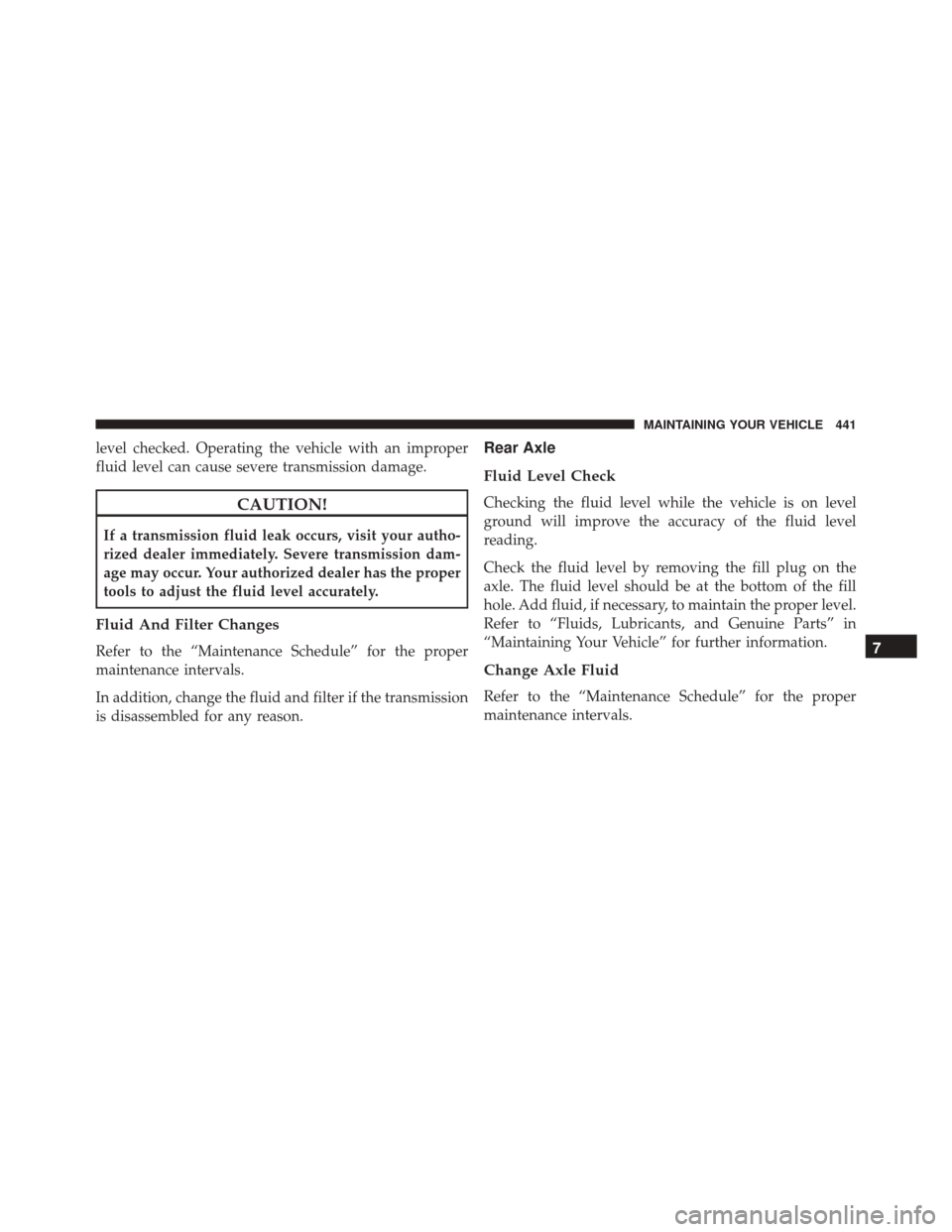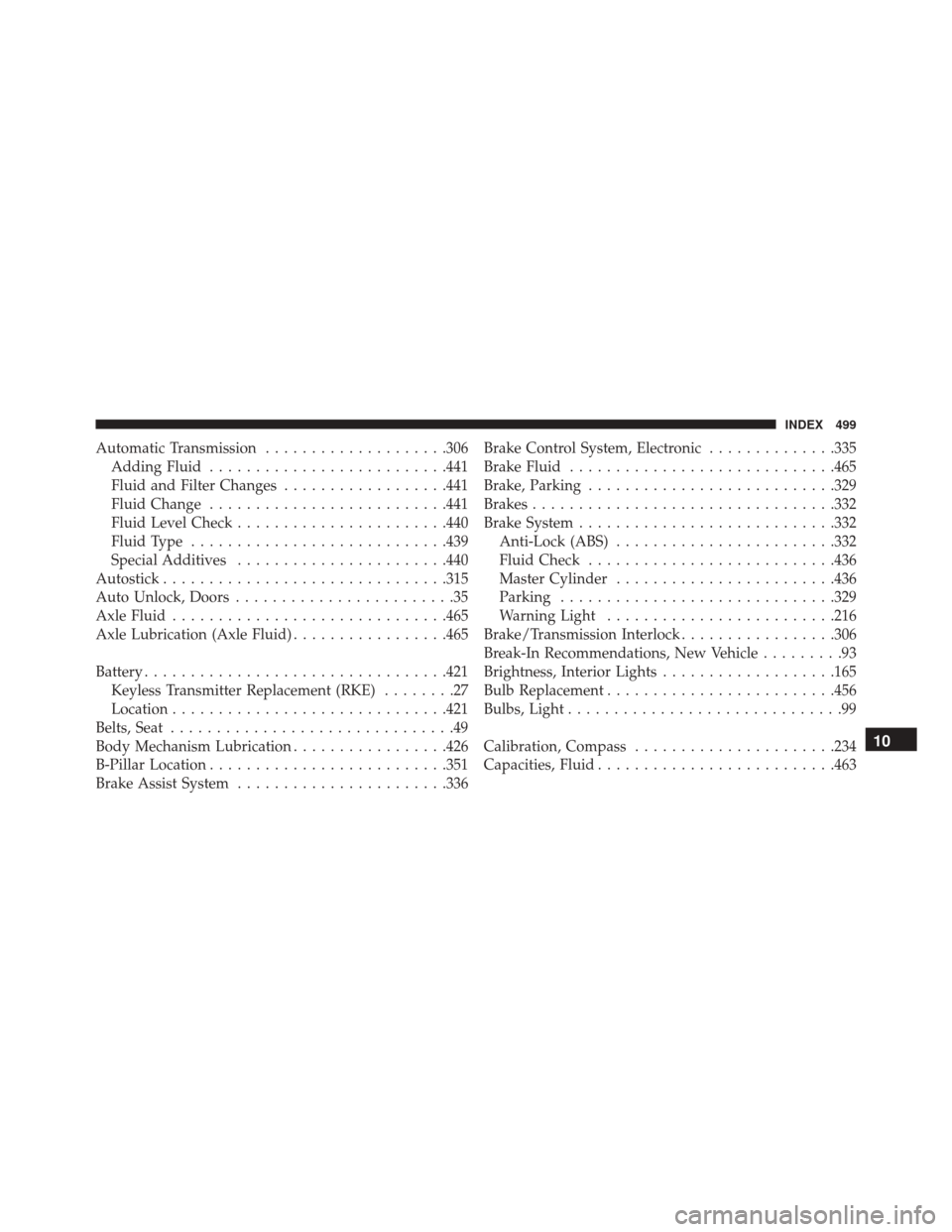2013 DODGE CHALLENGER SRT check transmission fluid
[x] Cancel search: check transmission fluidPage 96 of 520

Drive moderately during the first 500 mi (800 km). After
the initial 60 mi (100 km), speeds up to 50 or 55 mph (80
or 90 km/h) are desirable.
While cruising, brief full-throttle acceleration within the
limits of local traffic laws contributes to a good break-in.
However, wide-open throttle acceleration in low gear can
be detrimental and should be avoided.
The engine oil is a high performance synthetic lubricant,
the transmission fluid and axle lubricant installed at the
factory is high-quality and energy-conserving. Oil, fluid,
and lubricant changes should be consistent with antici-
pated climate and conditions under which vehicle opera-
tions will occur. For the recommended viscosity and
quality grades, refer to “Maintenance Procedures” in
“Maintaining Your Vehicle”.CAUTION!
Never use Non-Detergent Oil or Straight Mineral Oil
in the engine or damage may result.
NOTE: A new engine may consume some oil during its
first few thousand miles (kilometers) of operation. This
should be considered a normal part of the break-in and
not interpreted as an indication of difficulty. Please check
your oil level with the engine oil indicator often during
the break in period. Add oil as required.
SAFETY TIPS
Transporting Passengers
NEVER TRANSPORT PASSENGERS IN THE CARGO
AREA.
94 THINGS TO KNOW BEFORE STARTING YOUR VEHICLE
Page 397 of 520

4. Remove the cap from the valve stem and then screwthe fitting at the end of the Sealant Hose (6) onto the
valve stem.
5. Uncoil the Power Plug (8) and insert the plug into the vehicle’s 12 Volt power outlet.
NOTE: Do not remove foreign objects (e.g., screws or
nails) from the tire.
(C) Injecting TIREFIT Sealant Into The Deflated
Tire:
• Always start the engine before turning ON the TIRE-
FIT kit.
NOTE: Manual transmission vehicles must have the
parking brake engaged and the shift lever in NEUTRAL.
• After pressing the Power Button (4), the sealant (white
fluid) will flow from the Sealant Bottle (1) through the
Sealant Hose (6) and into the tire. NOTE:
Sealant may leak out through the puncture in the
tire.
If the sealant (white fluid) does not flow within0–10
seconds through the Sealant Hose (6):
1. Press the Power Button (4) to turn Off the TIREFIT kit. Disconnect the Sealant Hose (6) from the valve stem.
Make sure the valve stem is free of debris. Reconnect
the Sealant Hose (6) to the valve stem. Check that the
Mode Select Knob (5) is in the Sealant Mode position
and not Air Mode. Press the Power Button (4) to turn
On the TIREFIT kit.
2. Connect the Power Plug (8) to a different 12 Volt power outlet in your vehicle or another vehicle, if
available. Make sure the engine is running before
turning ON the TIREFIT kit.
3. The Sealant Bottle (1) may be empty due to previous use. Call for assistance.
6
WHAT TO DO IN EMERGENCIES 395
Page 420 of 520

CAUTION!(Continued)
•Your vehicle has been built with improved fluids
that protect the performance and durability of your
vehicle and also allow extended maintenance inter-
vals. Do not use chemical flushes in these compo-
nents as the chemicals can damage your engine,
transmission, power steering or air conditioning.
Such damage is not covered by the New Vehicle
Limited Warranty. If a flush is needed because of
component malfunction, use only the specified
fluid for the flushing procedure.
Engine Oil
Checking Oil Level
To assure proper engine lubrication, the engine oil must
be maintained at the correct level. Check the oil level at regular intervals, such as every fuel stop. The best time to
check the engine oil level is about five minutes after a
fully warmed engine is shut off.
Checking the oil while the vehicle is on level ground will
improve the accuracy of the oil level readings. Maintain
the oil level in the “SAFE” range. Adding 1.0 qt (1.0 L) of
oil when the reading is at the bottom of the “SAFE” range
will result in an oil level at the top of the “SAFE” range
on these engines.
CAUTION!
Overfilling or underfilling will cause oil aeration or
loss of oil pressure. This could damage your engine.
Change Engine Oil
The oil change indicator system will remind you that it is
time to take your vehicle in for scheduled maintenance.
Refer to “Maintenance Schedule” for further information.
418 MAINTAINING YOUR VEHICLE
Page 441 of 520

Manual Transmission – If Equipped
Fluid Level Check
Check the fluid level by removing the fill plug on the left
side of the transmission. The fluid level should be 1/4
inch (6.4mm) below the bottom of the fill hole. Add fluid,
if necessary, to maintain the proper level. Refer to “Flu-
ids, Lubricants, and Genuine Parts” in “Maintaining Your
Vehicle” for further information.
Change Transmission Fluid
If contaminated with water, change the fluid immedi-
ately. See your authorized dealer for service.
Refer to the “Maintenance Schedule” for the proper
maintenance intervals.
Automatic Transmission – If Equipped
Selection Of Lubricant
It is important to use the proper transmission fluid to
ensure optimum transmission performance and life. Use
only the manufacturer ’s specified transmission fluid.
Refer to “Fluids, Lubricants, and Genuine Parts” in this
section for fluid specifications. It is important to maintain
the transmission fluid at the correct level using the
recommended fluid. No chemical flushes should be used
in any transmission; only the approved lubricant should
be used.
CAUTION!
Using a transmission fluid other than the manufac-
turer ’s recommended fluid may cause deterioration
in transmission shift quality and/or torque converter
(Continued)
7
MAINTAINING YOUR VEHICLE 439
Page 442 of 520

CAUTION!(Continued)
shudder, and will require more frequent fluid and
filter changes. Refer to “Fluids, Lubricants, and
Genuine Parts” in this section for fluid specifica-
tions.
Special Additives
The manufacturer strongly recommends against using
any special additives in the transmission.
Automatic Transmission Fluid (ATF) is an engineered
product and its performance may be impaired by supple-
mental additives. Therefore, do not add any fluid addi-
tives to the transmission. The only exception to this
policy is the use of special dyes for diagnosing fluid
leaks. Avoid using transmission sealers as they may
adversely affect seals.
CAUTION!
Do not use chemical flushes in your transmission as
the chemicals can damage your transmission compo-
nents. Such damage is not covered by the New
Vehicle Limited Warranty.
Fluid Level Check
The fluid level is preset at the factory and does not
require adjustment under normal operating conditions.
Routine fluid level checks are not required, therefore the
transmission filler tube is capped and no dipstick is
provided.
Your authorized dealer can check your transmission fluid
level using a special service dipstick. If you notice fluid
leakage or transmission malfunction, visit your autho-
rized dealer immediately to have the transmission fluid
440 MAINTAINING YOUR VEHICLE
Page 443 of 520

level checked. Operating the vehicle with an improper
fluid level can cause severe transmission damage.
CAUTION!
If a transmission fluid leak occurs, visit your autho-
rized dealer immediately. Severe transmission dam-
age may occur. Your authorized dealer has the proper
tools to adjust the fluid level accurately.
Fluid And Filter Changes
Refer to the “Maintenance Schedule” for the proper
maintenance intervals.
In addition, change the fluid and filter if the transmission
is disassembled for any reason.
Rear Axle
Fluid Level Check
Checking the fluid level while the vehicle is on level
ground will improve the accuracy of the fluid level
reading.
Check the fluid level by removing the fill plug on the
axle. The fluid level should be at the bottom of the fill
hole. Add fluid, if necessary, to maintain the proper level.
Refer to “Fluids, Lubricants, and Genuine Parts” in
“Maintaining Your Vehicle” for further information.
Change Axle Fluid
Refer to the “Maintenance Schedule” for the proper
maintenance intervals.
7
MAINTAINING YOUR VEHICLE 441
Page 501 of 520

Automatic Transmission....................306
Adding Fluid ......................... .441
Fluid and Filter Changes ..................441
Fluid Change ......................... .441
Fluid Level Check ...................... .440
Fluid Type ........................... .439
Special Additives ...................... .440
Autostick .............................. .315
Auto Unlock, Doors ........................35
Axle Fluid ............................. .465
Axle Lubrication (Axle Fluid) .................465
Battery ................................ .421
Keyless Transmitter Replacement (RKE) ........27
Location ............................. .421
Belts, Seat ...............................49
Body Mechanism Lubrication .................426
B-Pillar Location ......................... .351
Brake Assist System ...................... .336Brake Control System, Electronic
..............335
Brake Fluid ............................ .465
Brake, Parking .......................... .329
Brakes ................................ .332
Brake System ........................... .332
Anti-Lock (ABS) ....................... .332
Fluid Check .......................... .436
Master Cylinder ....................... .436
Parking ............................. .329
Warning Light ........................ .216
Brake/Transmission Interlock .................306
Break-In Recommendations, New Vehicle .........93
Brightness, Interior Lights ...................165
Bulb Replacement ........................ .456
Bulbs, Light ..............................99
Calibration, Compass ..................... .234
Capacities, Fluid ......................... .463
10
INDEX 499
Page 505 of 520

Entry System, Illuminated....................21
Ethanol ............................... .376
Event Data Recorder ........................72
Exhaust Gas Caution ........................95
Exhaust System ...........................95
Exterior Folding Mirrors ....................107
Exterior Lighting ......................... .159
Exterior Lights ............................99
Filler Location Fuel ....................... .379
Filters Air Cleaner .......................... .420
Air Conditioning ...................... .285
Engine Oil ........................... .420
Engine Oil Disposal .....................420
Flashers Hazard Warning ....................... .388
Turn Signal ............................99
Flash-To-Pass ........................... .164Flooded Engine Starting
....................297
Fluid, Brake ............................ .465
Fluid Capacities ......................... .463
Fluid Leaks ..............................99
Fluid Level Checks Automatic Transmission ..................440
Brake ............................... .436
Cooling System ........................ .430
Engine Oil ........................... .418
Fluids, Lubricants and Genuine Parts ...........464
Fog Lights ............................. .162
Folding Rear Seat ........................ .156
Freeing A Stuck Vehicle .....................403
Fuel .................................. .375
Adding ............................. .379
Additives ............................ .377
Clean Air ............................ .375
Ethanol ............................. .376
Filler Cap (Gas Cap) .....................379
10
INDEX 503